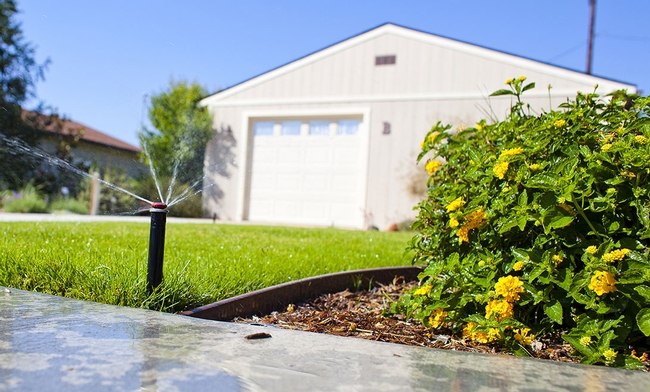
“Landscape irrigation represents well over half the water use in the average household,” Ingels said. “There are many proven ways to reduce high summer landscape water usage and these strategies will be especially critical this year due to the unprecedented drought in California.”
An expert in environmental horticulture, Ingels has maintained research and education programs for the University of California for 22 years on water conservation, deficit irrigation, sustainable landscaping and alternative turfgrass species. He also coordinates the UC Master Gardener program in Sacramento County.
In the spring, when the air temperature is in the 70s in much of California, lawns need about one-half to three-quarters of an inch of water per week, Ingels said. In the heat of the summer, water needs increase to about 1 inch to 1.5 inches per week. Knowing how much water to apply is half the battle. The other half is figuring out how much water is delivered by your irrigation system.
To calculate your home sprinklers' output, Ingels recommends conducting a catch can test. Place small cans with straight sides, like pet food or tuna cans, on the lawn in several places and run the sprinklers for 20 minutes. Use a ruler to measure the water in each can and determine the average. Multiply by three to get an hourly irrigation rate. Detailed information about various lawn species' water needs in different parts of California is outlined in the free UC Division of Agriculture and Natural Resources online publication Lawn Watering Guide for California. The document gives watering guidelines for warm season and cool season grass species growing in 10 climate regions in the state.
Loren Oki, UCCE specialist in the Department of Plant Sciences at UC Davis, a landscape horticulture expert, has conducted research on a wasteful but common residential lawn-watering problem in California: runoff.
“Much of the water that is applied to lawns runs directly into the gutters,” Oki said. “Not only is this wasted water, but we have found that the runoff carries pollutants – including pesticides and fertilizers – into the gutters and, eventually, into waterways. The problem is that typical sprinkler systems apply water faster than the soil can absorb it, which leads to runoff.”
To prevent runoff, use “cycle and soak,” a setting available on many irrigation controllers.
“This means the sprinklers come on for short periods with breaks in between to allow water to move into the soil,” Ingels said. “You'll still want to apply the full amount of water each of the days you're allowed to water, but you'll need a few hours between waterings to be sure it all soaks in.”
Sprinklers that spray a mist over lawns are another cause of water waste. Much of the water evaporates before it reaches the ground.
“You can save water by converting to rotary nozzles,” Ingels said. “The nozzles shoot out streams of water that provide very uniform watering. They have been shown to improve efficiency by 10 to 20 percent.”
In landscape borders, homeowners can save water by using a drip irrigation system. Drip irrigation will target water directly where the plants are growing, so no water is wasted wetting ground in areas where plant roots cannot reach. For optimal efficiency, the system must be carefully monitored throughout the growing season.
“Drip can be a great water saver, but it can also waste water if the system is poorly designed, if it's allowed to run too long, or if lines are accidentally cut with a shovel or other tool,” Ingels said.
Another water-saving strategy is preventing evaporation at the soil surface. Ingels suggests topping the soil with bark, wood chip, straw or other mulch.
“Bark and wood chips provide a long-lasting barrier to water evaporation from the soil,” he said. “Straw mulch works well in vegetable gardens. It saves water, keeps down weeds, and helps cool plant roots in the heat of the summer.”
Whatever irrigation system is used, Ingels said it is essential to check soil periodically throughout the year to determine how wet or dry it is and adjust the irrigation schedule as needed. The easiest way to check soil moisture, he said, is using a screwdriver.
“Just push a screwdriver down into the soil,” he said. “When the soil is moist, it will go all the way down. If the soil is moist only a few inches, the screwdriver will only go down that far.”
A more expensive soil sample tool, which pulls out a soil core, can be purchased at some nurseries and irrigation supply stores. Soil sampling provides more information about the soil, which is useful for making irrigation decisions.
UC Cooperative Extension and its Master Gardener program have abundant information on water conservation in the landscape:
- UC Guide to Healthy Lawns http://www.ipm.ucdavis.edu/TOOLS/TURF/
- Water use on Turfgrass and Landscape Plant Materials http://ucanr.edu/sites/UrbanHort/Water_Use_of_Turfgrass_and_Landscape_Plant_Materials/
- Drought: Gardening Tips http://cagardenweb.ucanr.edu/Drought_/Drought_Gardening_Tips_/
- Drought: Irrigation Tips http://cagardenweb.ucanr.edu/Drought_/Drought_Irrigation_Tips_/
- California Master Gardener programs (by county) http://camastergardeners.ucanr.edu/California_Counties_MG_Websites/
University of California Division of Agriculture and Natural Resources is celebrating 100 years of UC Cooperative Extension researchers and educators drawing on local expertise to conduct agricultural, environmental, economic, youth development and nutrition research that helps California thrive.
Media contacts:
- Chuck Ingels, UCCE advisor, Sacramento County, (916) 875-6527, cell (916) 835-7458, caingels@ucanr.edu
- Loren Oki, UCCE specialist, Department of Plant Sciences, UC Davis, (530) 754-4135, lroki@ucdavis.edu